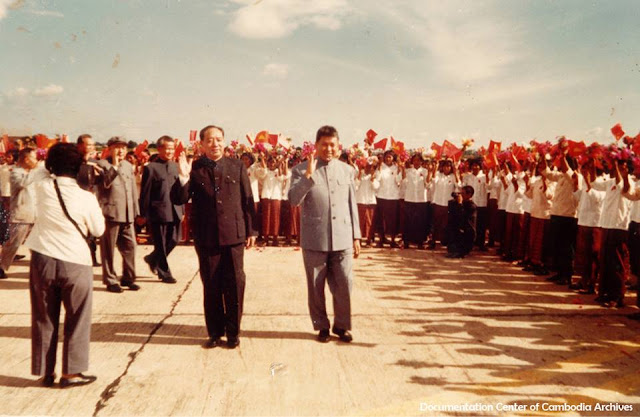ប៉ុល ពត និងគណប្រតិភូចិន វ៉ាង ឌុងស៊ីង នៅថ្ងៃទី៥ ខែវិច្ឆិកា ឆ្នាំ១៩៧៨។ ខៀវ សំផន និង នួន ជា ដើរនៅខាងក្រោយ។
១៩៩៨ - បូជាសព ប៉ុល ពត នៅស្រុកអន្លង់វែង ទីតាំងបូជាសពប៉ុល ពត ស្ថិតនៅលើផ្ទៃដីទំហំ១,២០៧ហិកតា ដែលមានចម្ងាយ១៣គីឡូម៉ែត្រពីរង្វង់មូលស្រុកអន្លង់វែង នៅតាមបណ្តោយផ្លូវជាតិ៦៧ នៅជាប់ច្រកព្រំដែនកម្ពុជា-ថៃ នៅជាំសាងាំ។ ទីតាំងបូជាសពនេះស្ថិតនៅលើភ្នំដងរែក ក្នុងភូមិជើងភ្នំ ឃុំត្រពាំងប្រីយ៍ ស្រុកអន្លង់វែង ខេត្តឧត្តរមានជ័យ។
ប៉ុល ពត ស្លាប់នៅថ្ងៃទី១៥ ខែមេសា ឆ្នាំ១៩៩៨ ដោយជំងឺគាំងបេះដូង។ អ្នកកាសែតអាមេរិកឈ្មោះ ណេត ថាយើរ៍ បានផ្តល់ថ្នាំសម្រាប់ចាក់ដើម្បីរក្សាសាកសពរយៈពេលពីរបីថ្ងៃ។ អ្នកកាសែតអន្តរជាតិជាច្រើនបានធ្វើដំណើរទៅដល់ទីនោះដើម្បីថតរូបសព និងធ្វើសេចក្តីរាយការណ៍ពីការស្លាប់របស់មេដឹកនាំខ្មែរក្រហមរូបនេះ។ ក្រុមអ្នកកាសែតមានចម្ងល់ថាហេតុអ្វីបានជាសាកសពរបស់ ប៉ុល ពត មានសក់ពណ៌ខ្មៅ។ នៅពេលដែល ប៉ុល ពត ត្រូវបានកាត់ទោសកាលពីមួយឆ្នាំមុន នាខែមីនា ឆ្នាំ១៩៩៧ ប៉ុល ពត មានសក់ស្កូវ។ ប្រពន្ធ ប៉ុល ពត បានឆ្លើយប្រាប់ទៅអ្នកកាសែតវិញថា៖ «ខ្ញុំបានលាបសក់ឲ្យគាត់ ដើម្បីក្លែងបន្លំភៀសខ្លួនទៅជំរំភូណយក្នុងដីថៃ ដែលជាជំរំចុងក្រោយរបស់ខ្មែរក្រហមនៅក្នុងខេត្តស៊ីសាកេត»។
បន្ទាប់មក អ្នកកាសែតបានយកសក់ ប៉ុល ពត ដើម្បីធ្វើកោសល្យវិច្ច័យ។ លទ្ធផលគឺដូចអ្វីដែលប្រពន្ធរបស់ ប៉ុល ពត បាននិយាយមែន។ សពរបស់ ប៉ុល ពត ត្រូវបានបូជានៅថ្ងៃទី១៧ ខែមេសា ឆ្នាំ១៩៩៨ នៅវេលាម៉ោង១០ព្រឹក ដែលស្ថិតនៅចម្ងាយប្រហែល១០ម៉ែត្រពីផ្ទះខ្ទមរបស់គាត់។ គ្មាននរណាម្នាក់ចូលរួម ក្រៅតែពីយោធាខ្មែរក្រហមឡើយ។ ដោយសារនាពេលនោះ កងកម្លាំងរាជរដ្ឋាភិបាលកំពុងវាយសម្រុកចូលយ៉ាងខ្លាំង ហើយយោធាខ្មែរក្រហមភាគច្រើនរត់គេចពីតំបន់នោះ។ យោធាដែលនៅសេសសល់មិនអាចរកអុសឲ្យបានគ្រប់គ្រាន់ដើម្បីបូជាសពបាននោះទេ។ យោធាទាំងនោះបានប្រមូលកៅអីឫស្សី សាឡុង និងកៅអីធ្វើពីផ្តៅ ព្រមទាំងកង់ឡានចាស់ៗ ដាក់ដុតជាមួយគ្នា។ យោធាខ្មែរក្រហមទាំងនោះមិនបានរើសឆ្អឹងទុកនោះទេ។ ឆ្អឹងទាំងអស់ត្រូវទុកចោលនៅកន្លែងដុតសពនោះតែម្តង។
1978 -- POL POT
Pol Pot walks with Chinese official Wang Dong Xing (centre left) during a Chinese delegation visit to Democratic Kampuchea on November 5, 1978. Khieu Samphan and Noun Chea walking behind them.
1998 -- CREMATION SITE OF POL POT, ANLONG VENG DISTRICT
Comprising 1.207 hectares, the cremation site of Pol Pot is located 13 kilometers from the roundabout of Anlong Veng District along National Road 67 near the Cambodian-Thai border checkpoint at Choam Sra Ngam. It is situated in the Dangrek Mountains in Cheung Phnom Village, Trapeang Prey Commune, Anlong Veng District, Oddar Meanchey Province.
Without access to medicine or oxygen therapy, Pol Pot died of cardiac arrest on April 15, 1998. Nate Thayer, an American journalist, assisted in providing materials to preserve the body for a few days. International journalists arrived to photograph the scene and report on the death of the Khmer Rouge leader. Journalists wondered why Pol Pot’s corpse had black hair, since his hair had been grey when he was sentenced a year earlier in March 1997. Pol Pot’s wife responded, “I dyed his hair black in order to disguise him when we fled to Phou Nay Camp in Thailand, which was the last Khmer Rouge camp in Sisaket Province [Thailand]. Later, a journalist took a lock of his hair to be tested and the result confirmed what his wife had said. Pol Pot’s body was cremated just ten meters away from his cottage at 10:00 a.m. on April 17, 1998. No one was present except Khmer Rouge soldiers. Because the government forces were advancing, most of the Khmer Rouge soldiers had already fled the area. The soldiers who remained could not manage to find enough wood to make a funeral pyre, so they gathered whatever materials were available, such as bamboo, rattan chairs, sofas, and old tires. The soldiers did not collect the cremains, but left it there.
Source: Documentation Center of Cambodia Archives











No comments:
Post a Comment